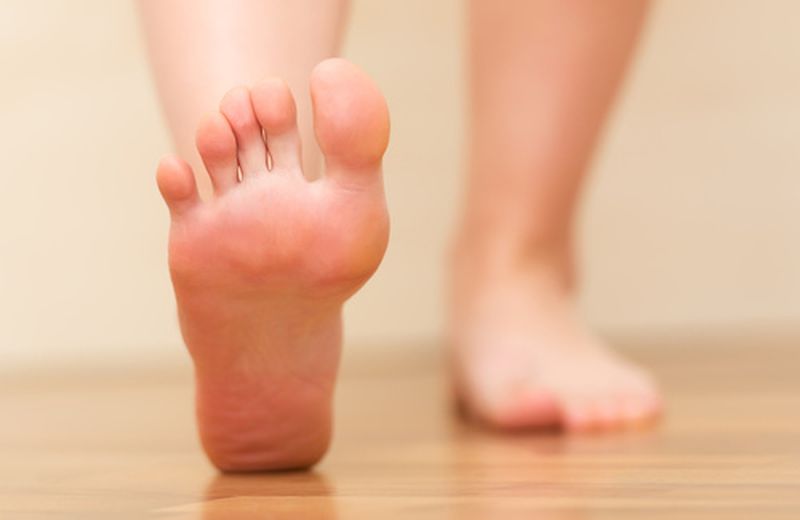Hallux valgus: how to relieve pain?
Hallux valgus is a bone deformation of the foot, often associated with women and the elderly, which however does not spare men and young people under 40. It is a common but very annoying disorder, from an aesthetic and above all functional point of view. Let’s find out how to relieve the painful symptoms of this pathology with natural remedies.

- What is hallux valgus
- Causes of hallux valgus
- How to tell if you have hallux valgus: the symptoms
- Consequences of hallux valgus
- How to cure hallux valgus
- Natural remedies for hallux valgus
What is hallux valgus
Hallux valgus is, together with hammer toe , one of the most common pathologies that develop on the foot . It appears as a lateral deviation of the big toe: the first metatarsal bone moves progressively outwards, while the phalanx moves gradually towards the other toes , arriving in the most serious cases to overlap the second toe.
Causes of hallux valgus
According to statistics, it is a disorder that has a greater incidence on women of mature age , but it is not uncommon for it to also occur at a young age or in men.
For this reason, the underlying causes of the onset of hallux valgus can be of different types.
We talk about:
- Primitive hallux valgus , when the causes are essentially genetic or constitutional and there are previous familiarities with this pathology;
- secondary hallux valgus , when there are acquired causes, including auto-common diseases, for example rheumatoid arthritis, degenerative or post-traumatic.
The use of unsuitable footwear , with a too narrow sole or toe and high heels, or problems related to weight, posture or muscle tone, can promote or worsen bunion pain.
How do you know if you have hallux valgus, the symptoms
Since it is a deformation of the joint , one of the first symptoms that can be noticed is precisely the pain in the bone of the big toe , often characterized by a bursitis , that is an acute inflammation, and the consequent swelling or redness around the base of the toe (the so-called “onion” of the foot).
Further signs to be taken into account are persistent or intermittent pain, even when the area is not directly solicited, a thickening of the skin in the affected part, a limited ability to mobilize the forefoot and toes , up to the most advanced stages. difficulty walking.
In these cases,a specialist visit to the orthopedist is recommended , who will be able to provide a correct diagnosis through a clinical evaluation and possibly prescribe other assessment tests (x-ray, CT scan or magnetic resonance imaging), to assess the severity of the pathology and suggest possible remedies.
Shoes and posture: how much heel to wear?
Consequences of hallux valgus
In addition to the aesthetic aspect and pain, there are also consequences on the functional level : the hallux valgus in fact risks affecting the whole posture and can have consequences that affect the whole organism. This is because the feet are the roots on which we rest and condition the axis and movements of the body from the legs up, towards the spine. Improper foot rest on the ground
and poor posture can lead to muscle problems, joint pain and even imbalances in the functioning of internal organs.
How to cure hallux valgus
Hallux valgus is a degenerative disease that is difficult to counter . Depending on the severity of the disorder, you can choose to proceed essentially in two ways:
- Non-surgical or conservative treatments , or natural remedies that can be adopted to relieve symptoms and better manage the discomfort due to a painful hallux valgus.
- Surgical treatments . The classic surgical intervention, which consists in the removal of bone tissues and the insertion of supports to keep the big toe in its correct alignment, is accompanied by the most recent percutaneous surgical approach (PBS), less invasive and with post-recovery times. shorter operators, which allows to act directly on the bone, without surgical opening of the skin.
Natural remedies for hallux valgus
By conservative treatments we mean all those remedies without intervention useful to stem the discomfort and the course of the disease, but these are good habits that would be good to adopt to ensure good health of our feet and to prevent other annoying joint problems, such as for example arthrosis of the foot .
Here are some remedies for hallux valgus :
- Walk often barefoot , training the foot to articulate the step in the correct way;
- doing exercises for hallux valgus , to strengthen the muscles and support structures of the foot and to maintain good mobility: massage the sole of the foot on a tennis ball; move your fingers in all directions; push the big toes to the ground and lift the other toes and vice versa; shift the weight from the metatarsal to the heel and vice versa; use your fingers to grab a pencil or handkerchief;
- wear comfortable shoes , especially in the case of physical activity or long walks;
- use an orthotic or a brace for hallux valgus, to maintain correct bone alignment of the foot;
- in moments of acute inflammation, apply ice to the affected area;
- massage the feet with oils , ointments or creams with anti-inflammatory properties, such as castor oil, almond oil, wheat germ oil, turmeric or arnica;
- make foot baths with Epsom salt or essential oils that relieve pain: lavender, tea tree or rosemary are very suitable;
- make compresses with clay , which has anti-inflammatory and pain-relieving properties;






























+ There are no comments
Add yours